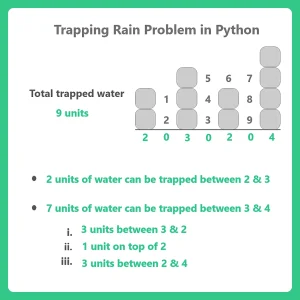Python Program for Trapping Rain Water Problem
Trapping Rain Water in Python
Here, in this page we will discuss one of the famous problem of Trapping Rain Water in Python . We are given with n non-negative integers representing an elevation map where the width of each bar is 1, we need to compute how much water it is able to trap after raining.
Example :
- Input : arr = [2,0,3,0,2,0,4]
- Output : 9
- Explanation : We can trap “2 units” of water between 2 and 3, “7 units” between 3 and 4 (“3 units” between 3 and 2 , “1 unit” on top of bar 2 and “3 units” between 2 and 4.

Algorithm
- Start
- Initialize three variables with value zero named as ans, temp, prev
- Iterate entire array using variable i
- if arr[i] is greater then prev and temp is zero then assign the value or arr[i] to prev
- else if arr[i] is greater then or equals to prev then add temp to ans, assign arr[i] to prev and temp to zero
- else check if arr[i] is not the last element of arr and arr[i] is less then maximum of arr[i+1 : ] then assign difference of prev and arr[i] to temp else add arr[i to ans, assign temp to zero and prev to arr[i]
- Print value of answer

Python code
Run
def rain(arr):
ans = 0
temp = 0
prev = 0
for i in range(len(arr)):
if arr[i] > prev and temp == 0:
prev = arr[i]
elif arr[i] >= prev:
ans += temp
prev = arr[i]
temp = 0
else:
if i != len(arr)-1 and arr[i] < max(arr[i+1:]):
temp += prev - arr[i]
else:
ans += arr[i]
temp = 0
prev = arr[i]
return ans
arr = [2, 0, 3, 0, 2, 0, 4]
print(rain(arr))Output
9
Prime Course Trailer
Related Banners
Get PrepInsta Prime & get Access to all 200+ courses offered by PrepInsta in One Subscription
If you want to practice similar Questions click on the given button.






Login/Signup to comment